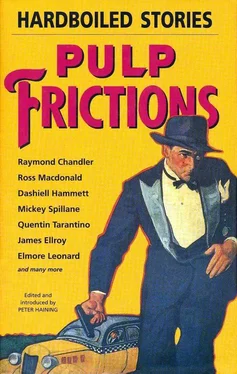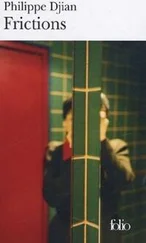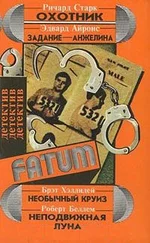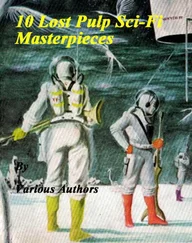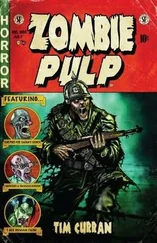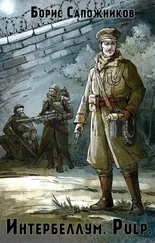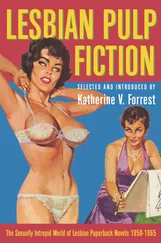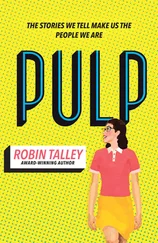But we didn’t know nothing about it then and after we done got the head and the old man was gone and a couple of boys that afternoon found the body and not no head on it, and the pot was found, and them old people from the Methodist Church done told their story and one thing another, we figured out that Hutch done it, specially on account he must of been drunk and he done time in the pen and all like of that, and nobody ain’t thought nothing about Burbie. They had the funeral and Lida cried like hell and everybody tried to figure out what Hutch wanted with the head and things went along thataway for three weeks.
Then one night down to the poolroom they was having it some more about the head, and one says one thing and one says another, and Benny Heath, what’s a kind of a constable around town, he started a long bum argument about how Hutch must of figured if they couldn’t find the head to the body they couldn’t prove no murder. So right in the middle of it Burbie kind of looked around like he always done and then he winked. And Benny Heath, he kept on a-talking, and after he got done Burbie kind of leaned over and commence to talk to him. And in a couple of minutes you couldn’t of heard a man catch his breath in that place, accounten they was all listening at Burbie.
I already told you Burbie was pretty good when it come to giving a spiel at a entertainment. Well, this here was a kind of a spiel too. Burbie act like he had it all learned by heart. His voice trimmled and ever couple of minutes he’d kind of cry and wipe his eyes and make out like he can’t say no more, and then he’d go on.
And the big idea was what a whole lot of hell he done raised in his life. Burbie said it was drink and women what done ruined him. He told about all the women what he knowed, and all the saloons he’s been in, and some of it was a lie ’cause if all the saloons was as swell as he said they was they’d of throwed him out. And then he told about how sorry he was about the life he done led, and how hope my die he come home to his old home town just to cut out the devilment and settle down. And he told about Lida, and how she wouldn’t let him cut it out. And then he told how she done led him on till he got the idea to kill the old man. And then he told about how him and Hutch done it, and all about the money and the head and all the rest of it.
And what it sounded like was a piece what he knowed called ‘The Face on the Floor’, what was about a bum what drawed a picture on the bar room floor of the woman what done ruined him. Only the funny part was that Burbie wasn’t ashamed of hisself like he made out he was. You could see he was proud of hisself. He was proud of all them women and all the liquor he’d drunk and he was proud about Lida and he was proud about the old man and the head and being slick enough not to fall in the creek with Hutch. And after he got done he give a yelp and flopped down on the floor and I reckon maybe he thought he was going to die on the spot like the bum what drawed the face on the bar room floor, only he didn’t. He kind of lain there a couple of minutes till Benny got him up and put him in the car and tooken him off to jail.
So that’s where he’s at now, and he’s went to work and got religion down there, and all the people what comes to see him, why he sings hymns to them and then he speaks them his piece. And I hear tell he knows it pretty good by now and has got the crying down pat. And Lida, they got her down there too, only she won’t say nothing ’cepting she done it same as Hutch and Burbie. So Burbie, he’s going to get hung, sure as hell. And if he hadn’t felt so smart, he would of been a free man yet.
Only I reckon he done been holding it all so long he just had to spill it.
The Deadly Circle
Samuel Fuller
The name Samuel Fuller is not one readily associated with hardboiled fiction, but rather with a controversial film-maker whose violent and brutal films have made him a cult hero, especially in France where he is now considered one of the most influential postwar directors. Yet Fuller, who has written many of the screenplays for his pictures, began his career writing short stories for the pulp magazines and published several hardboiled novels, including the gruesome Burn, Baby, Burn (1935). Though long out of print and difficult to trace, all these works demonstrate his abiding fascination with people who are corrupt and amoral — themes which also run through many of his pictures. As Ephraim Katz has written in his International Film Encyclopedia (1980), ‘Fuller’s output, mostly action pictures of the B category, reflects in its directness and brutal violence his experiences as a crime reporter, a tramp and a soldier... while his crude political views, basically conservative and chauvinistic, have alienated critics of both the extreme Left and the extreme Right. ’ This said, few would disagree that Sam Fuller has been a vital force in the American cinema, and critic Andrew Sarris has called him ‘an authentic American primitive’, citing the exciting visual style of his movies such as Pickup on South Street (1953), Underworld USA (1961), The Naked Kiss (1965) and The Klansman (1974).
Born in Worcester, Massachusetts, in 1911, Fuller began working at the age of 12 as a copyboy on the New York Journal and at 17 was a crime reporter for the San Diego Sun. During the Depression years he was a hobo, wandering about the countryside, riding on freight trains from place to place. He then began to use his natural talent as a storyteller to contribute to the pulp magazines. His first tales appeared in Underworld, a gaudy, all-action monthly which was published in Springfield, Massachusetts, not far from his own home town, and whose editor clearly shared Fuller’s fascination with American low-life. Supported by the income from these stories, he began to churn out pulp novels, then in 1936 decided to try his hand at film scripts and two years later collaborated on the notorious Gangs of New York with James Cruze. During the years of the Second World War he was an exemplary soldier in the US Army, fighting in Europe and North Africa where he won several awards for bravery, including a Purple Heart. On his return to Hollywood he began the film career which has since made him so admired in many quarters and so reviled in others.
Even in the days when he was writing pulp fiction, Fuller made full use of his first-hand experiences as a crime reporter and rolling stone — as his hardboiled story ‘The Deadly Circle’, written for Underworld in May 1934, clearly shows. And in Mike Halpeny, the cruel and ruthless protagonist of the story, is the same kind of figure who would return time and again under different names in Sam Fuller’s extraordinary movies...
* * *
Mike Halpeny made an incongruous picture as he scurried down the grass-grown road which crossed the Canadian boundary from New York, The road he was on had been made by loggers and trappers nearly a century ago. It had then lapsed into a deer trail until American prohibition opened it again as an excellent route for smugglers. It meandered through a rugged, almost primeval forest from the Adirondacks far into Canada. Mike Halpeny, a New York gunman, was hurrying along this road, a half hour before sunset, dressed as he probably would have dressed for a stroll along Fifth Avenue, except that now he carried in his right hand a Winchester rifle of the latest model. This rifle was loaded and unlocked.
Mike had parked his car a quarter of a mile back.
Mike wanted to kill Jake Connti with one single shot. He knew old Jake fairly well.
He walked another quarter of a mile before coming to the selected spot. It was a place where the road dipped abruptly into a narrow valley at the bottom of which was a gorge, a mere crack in the earth. The second-growth birch and spruce, which crowded the old road elsewhere, here swayed back on both sides leaving a small open space which was covered with stunted shrubs and glacial rocks.
Читать дальше
